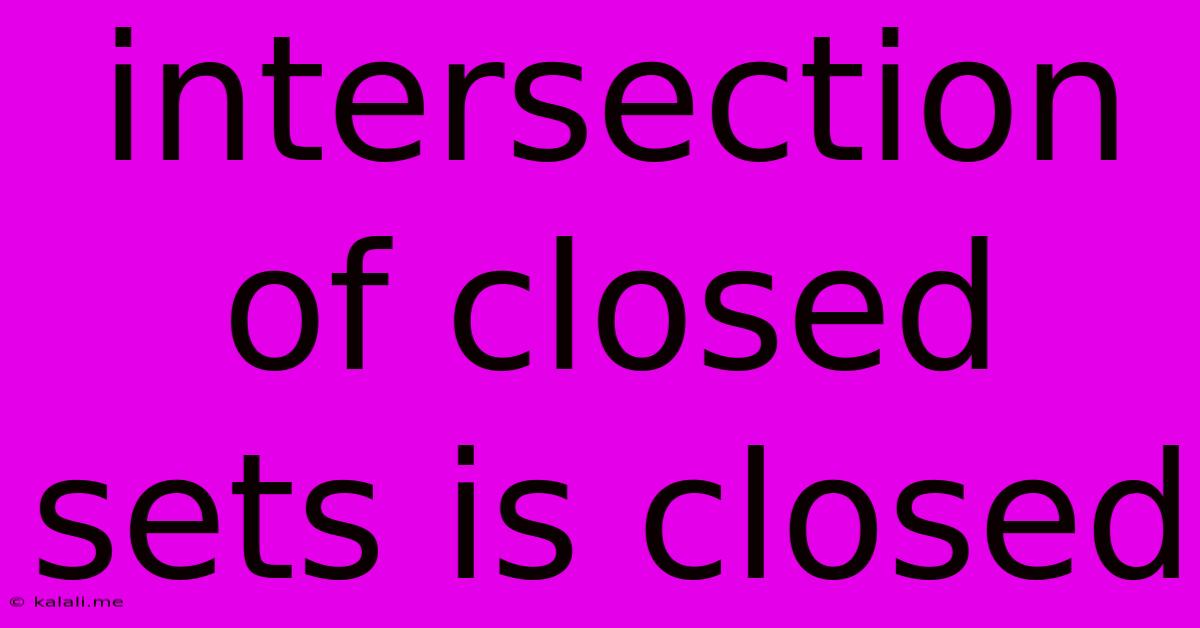Intersection Of Closed Sets Is Closed
Kalali
Jun 01, 2025 · 3 min read

Table of Contents
The Intersection of Closed Sets is Closed: A Proof and Explanation
This article will delve into a fundamental concept in topology: proving that the intersection of any number of closed sets is itself a closed set. This is a crucial theorem with implications across various mathematical fields. Understanding this proof not only strengthens your understanding of topology but also improves your ability to work with set theory and limit arguments. We'll break down the proof step-by-step, providing clear explanations along the way.
What are Closed Sets?
Before we dive into the proof, let's briefly define what a closed set is. In a metric space (like the real numbers or Euclidean space), a set is considered closed if it contains all its limit points. A limit point is a point where every neighborhood contains at least one point from the set (other than the point itself). Alternatively, a set is closed if its complement is open. An open set, conversely, is a set where every point has a neighborhood entirely contained within the set.
Proof: Intersection of Closed Sets is Closed
We aim to prove that if {Cᵢ} is a collection of closed sets (where i belongs to some index set I), then their intersection ∩ᵢ∈ᵢ Cᵢ is also a closed set. We'll accomplish this by showing that the complement of the intersection is open.
-
Consider the complements: Let's consider the complement of each closed set Cᵢ. We denote this as Cᵢᶜ. Because each Cᵢ is closed, its complement Cᵢᶜ is open (by the definition of a closed set).
-
The De Morgan's Law: Applying De Morgan's Law to the intersection of the closed sets, we get:
(∩ᵢ∈ᵢ Cᵢ)ᶜ = ∪ᵢ∈ᵢ Cᵢᶜ
This means the complement of the intersection of the closed sets is equal to the union of their complements.
-
Union of Open Sets: Since each Cᵢᶜ is open (as established in step 1), the union of these open sets (∪ᵢ∈ᵢ Cᵢᶜ) is also open. This is a fundamental property of open sets: the arbitrary union of open sets is always open.
-
Conclusion: We have shown that the complement of the intersection of closed sets (∩ᵢ∈ᵢ Cᵢ)ᶜ is open. Therefore, by the definition of a closed set, the intersection ∩ᵢ∈ᵢ Cᵢ must be closed.
Illustrative Example
Consider the closed intervals [0, 1] and [1, 2] on the real number line. Both are closed sets. Their intersection is {1}, which is also a closed set (it contains its only limit point, which is itself). This simple example demonstrates the theorem in action.
Why is this important?
This theorem is a building block in many areas of mathematics. It's crucial for:
- Topology: Understanding the properties of closed sets is fundamental to topology, which studies the properties of spaces that are preserved under continuous deformations.
- Real Analysis: This theorem helps in analyzing the behavior of sequences and functions in real analysis.
- Functional Analysis: It plays a role in defining closed subspaces of vector spaces.
Further Exploration
While this article focuses on the proof, understanding the implications of this theorem requires further exploration of concepts like metric spaces, open sets, limit points, and topological spaces. Delving deeper into these areas will solidify your grasp of this fundamental topological result. Understanding this proof builds a solid foundation for advanced mathematical studies.
Latest Posts
Latest Posts
-
Kirby And The Forgetton Land Coins
Jun 03, 2025
-
Why Was John The Baptist In Prison
Jun 03, 2025
-
Can I Download A Single Tab In Google Sheets
Jun 03, 2025
-
How To Get Rid Of Fingerprints
Jun 03, 2025
-
Calories In Cup Of Uncooked Rice
Jun 03, 2025
Related Post
Thank you for visiting our website which covers about Intersection Of Closed Sets Is Closed . We hope the information provided has been useful to you. Feel free to contact us if you have any questions or need further assistance. See you next time and don't miss to bookmark.